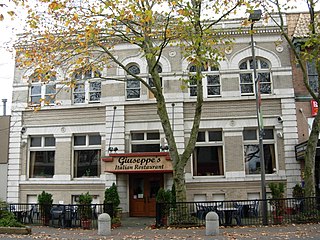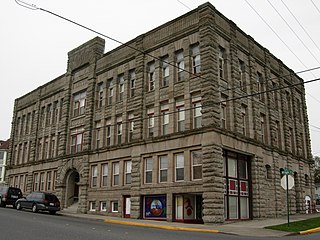
Bellingham is the county seat and most populous city of Whatcom County in the U.S. state of Washington. Located 52 miles (84 km) southeast of Vancouver, British Columbia, 90 miles (140 km) north of Seattle, and 21 miles (34 km) south of the U.S.–Canada border, Bellingham is in between two major metropolitan areas, Seattle and Vancouver, British Columbia. The city had a population of 80,885 as of the 2010 census and is estimated to have 92,314 in 2019.

Whatcom County is located in the U.S. state of Washington. As of the 2010 census, the population was 201,140. It is bordered by Metro Vancouver Regional District and Fraser Valley Regional District in Canada on the north, Okanogan County on the east, Skagit County on the south, and the Salish Sea on the west. The county seat and largest city is Bellingham.

Fairhaven was a settlement in Washington state founded in 1883 by Dan Harris. In 1903, it became part of the city of Bellingham.

Julius Harold Bloedel was an American businessman and entrepreneur who operated primarily in the Pacific Northwest region of the United States and Canada.

Lake Whatcom is located in Whatcom County, Washington, United States. It is the drinking water source for approximately 85,000 residents in the city of Bellingham as well as Whatcom County. It is approximately 10 miles (16 km) in length and 1 mile (1.6 km) in width at its widest. Lake Whatcom is located and managed within three political jurisdictions: the city of Bellingham, Whatcom County, and the Lake Whatcom Water and Sewer District. The lake is a popular area for motor boating, swimming, fishing, and other recreational activities.
The Bellingham riots occurred on September 4, 1907, in Bellingham, Washington, United States. A mob of 400–500 white men, predominantly members of the Asiatic Exclusion League, with intentions to exclude East Indian immigrants from the work force of the local lumber mills, attacked the homes of the South Asian Indians. The Indians were mostly Sikhs but were labelled as Hindus by much of the media of the day.

Port Gamble is an unincorporated community on the northwestern shore of the Kitsap Peninsula in Kitsap County, Washington, United States. It is also a small, eponymous bay, along which the community lies, near the entrance to Hood Canal. The unincorporated communities of Port Gamble and Little Boston, part of Kitsap County, lie on the west and the east side, respectively, of the mouth of this bay. The Port Gamble Historic District, a U.S. National Historic Landmark, covers one of the nation's best-preserved western lumber towns.

State Route 539 is a north–south state highway in the U.S. state of Washington. The highway travels through northwestern Whatcom County and connects Interstate 5 (I-5) in Bellingham with Lynden and the Canadian border near Langley, British Columbia. Its name, the Guide Meridian, is derived from the Guide meridian that it follows while traveling due north–south.
KMRE-LP is a radio station broadcasting local and regional educational, cultural and historic programming. The station is located in Bellingham, Washington.

The George Peabody House Museum is a historic house museum at 205 Washington Street in Peabody, Massachusetts. It is dedicated to the life and deeds of 19th century U.S. entrepreneur, philanthropist, and namesake of the city, George Peabody. The museum shares its location with the Peabody Leather Museum. Within its walls, in 1795, George Peabody was born in what was then called South Danvers.

The T.G. Richards and Company Store, also known as Whatcom County Courthouse and James B. Steadman Post No. 24, is the first and oldest brick building in the state of Washington, United States, and is listed on the U.S. National Register of Historic Places.

The John Whipple House is a historic colonial house at 53 South Main Street in Ipswich, Massachusetts. Built in the seventeenth century, the house has been open to the public as a museum since 1899, and was the subject of some of the earliest attempts at the preservation of colonial houses. It was designated a National Historic Landmark in 1960, one of the earliest properties to receive that honor.

This is a list of the National Register of Historic Places listings in Whatcom County, Washington.
The history of Bellingham, Washington, as it is now known, begins with the settling of Whatcom County in the mid-to-late 19th century.

The Whatcom Museum was originally built in 1892 as the city hall for the former town of New Whatcom, before it was joined with surrounding towns to form Bellingham, Washington. The building was designed in a Late Victorian style by Alfred Lee, a local architect, who used red brick and Chuckanut Sandstone for its construction. The design itself was an almost exact replica of the second Saginaw County Courthouse in Saginaw, Michigan, Designed by Fred W. Hollister.
Bellingham Bay and British Columbia Railroad was built in the northwestern part of Washington, between the town of Whatcom, now Bellingham, then to the town of Sumas, to connect with the Canadian Pacific Railway for a continental connection.

Fort Bellingham (1856–1860) was a U.S. Army fort built to prevent attacks by Indians from Canada and from Russian territory, on the bayside villages of Fairhaven, Sehome and Whatcom.

The B. P. O. E. Building, otherwise known as the Elks Club was originally built for the Bellingham chapter of the Benevolent and Protective Order of Elks in 1912, during the city's second major building boom. It is located within the vicinity of the old Federal Building on Cornwall Avenue, historically known as Dock Street. The Elks no longer occupy the building and it is now home to an Italian restaurant. It was listed on the National Register of Historic Places on March 26, 1992.

The Thomas Forsyth House is the historic home of an early settler of Toquerville, Utah. One of the Mormon pioneers, Thomas Forsyth built the house circa 1868 and lived there until his death in 1898. He operated mills, dried fruit and stocked the cellar with wine he made himself, while his wife Mary Browett Holmes ran a glove shop. The simple 1½-story fieldstone construction, a hall-and-parlor house extended with a lean-to, is representative of the pioneer period.

The Lottie Roth Block is an historic commercial building located near downtown Bellingham, Washington and is listed on the U.S. National Register of Historic Places. Built by quarry manager and Washington State Legislator Charles Roth and named after his wife, Lottie, the building is clad in the famous Chuckanut Sandstone from his Bellingham Bay Quarry that would be used in countless building projects across the region. Completed in 1891, it was one of the last large commissions of noted Northwest architect Elmer H. Fisher and his only project in Whatcom County. While initially built as an office/retail building in anticipation of the commercial expansion of the town of Whatcom, it was converted entirely to Apartments by 1918 when commercial development moved in the opposite direction towards New Whatcom, which after 1903 became the new city of Bellingham's downtown. Still strictly serving as a residential building to the current day, the Lottie Roth Block was listed on the National Register of Historic Places on December 12, 1978.

























